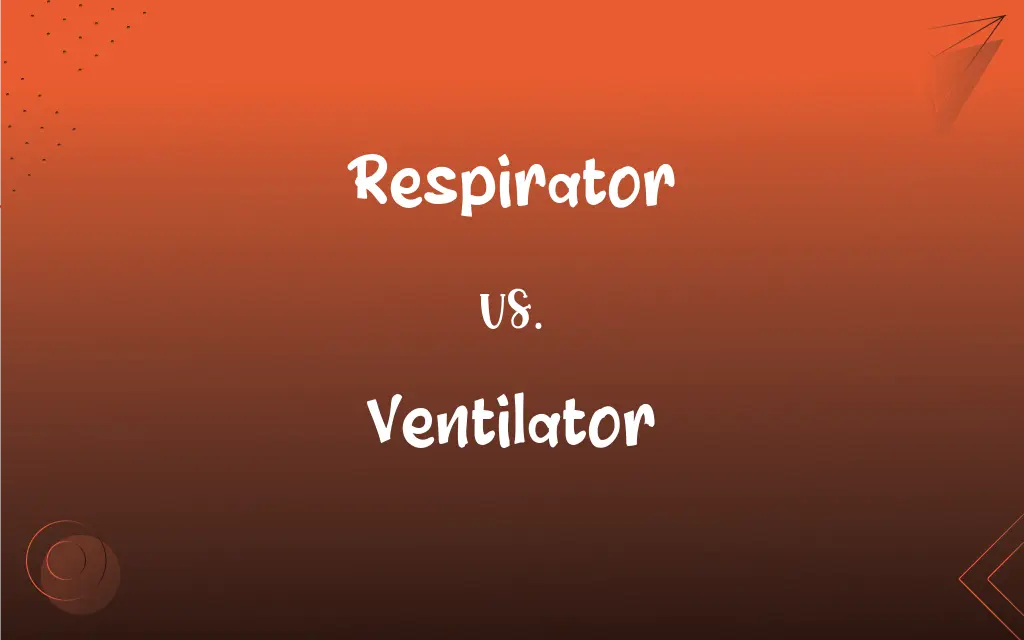Respirator vs. Ventilator: What's the Difference?
Edited by Aimie Carlson || By Harlon Moss || Updated on October 18, 2023
A respirator is a protective mask filtering air particles, while a ventilator is a machine aiding or replacing a person's breathing.

Key Differences
Respirators are devices designed primarily to protect the wearer from inhaling harmful dust, fumes, vapors, or gases. They come in various forms, including masks and facepieces. Ventilators, on the other hand, are medical machines that support or replace spontaneous breathing in patients.
Wearing a respirator can be essential in environments where harmful airborne particles are present. They ensure that the air inhaled is filtered, removing any harmful substances. Ventilators, conversely, are employed in healthcare settings, especially for patients who are unable to breathe adequately on their own due to various medical conditions.
Respirators often require proper fitting to ensure maximum protection. They might be disposable or reusable, and their use is common in industries like construction, mining, or chemical handling. Ventilators, being complex medical devices, require careful monitoring and adjustments based on a patient's needs, often overseen by trained healthcare professionals.
While the main goal of a respirator is protection from external harmful elements, the main purpose of a ventilator is therapeutic. It's used to ensure that patients get the right amount of oxygen and that carbon dioxide is adequately removed from their bodies.
The need for respirators often arises in occupational settings where workers are exposed to hazards. In contrast, the need for ventilators arises in medical situations, such as intensive care units, where patients might be dealing with respiratory diseases, surgical procedures, or other ailments that impair their ability to breathe independently.
ADVERTISEMENT
Comparison Chart
Primary Purpose
Protect from airborne particles
Aid or replace spontaneous breathing
Usage
Occupational settings
Medical settings
Dependency
User-dependent (must wear correctly)
Patient-dependent (requires monitoring)
Nature
Filter
Machine
Interaction with External Air
Filters harmful elements
Delivers or removes air to/from patient
ADVERTISEMENT
Respirator and Ventilator Definitions
Respirator
Equipment preventing inhalation of pollutants.
Workers in the coal mine use respirators for safety.
Ventilator
A machine assisting or controlling breathing.
The patient was placed on a ventilator to support his respiratory functions.
Respirator
A mask filtering out harmful particles.
In the dusty environment, a respirator is essential.
Ventilator
An apparatus aiding patients who can't breathe independently.
Post-surgery, she needed a ventilator for a short duration.
Respirator
A protective device for breathing.
He wore a respirator while spray painting the wall.
Ventilator
Medical equipment for respiratory support.
The rise in respiratory illnesses increased the demand for ventilators.
Respirator
A barrier against harmful airborne substances.
Before entering the chemical lab, she put on her respirator.
Ventilator
A machine regulating airflow for patients.
With his respiratory condition worsening, the doctor recommended a ventilator.
Respirator
A facepiece filtering airborne contaminants.
During the wildfire, everyone was advised to have a respirator on hand.
Ventilator
A device supplying fresh air to replace stale air.
In the ICU, the patient's life was sustained by a ventilator.
Respirator
See ventilator.
Ventilator
A device that circulates fresh air and expels stale or foul air.
Respirator
A device worn over the mouth or nose or both to protect the respiratory tract from harmful dust or fumes.
Ventilator
(Medicine) A machine that supplies oxygen or a mixture of oxygen and air, used in artificial respiration to control or assist breathing. Also called respirator.
FAQs
How does a ventilator work?
A ventilator either aids or replaces spontaneous breathing by supplying fresh air to or removing stale air from a patient.
Who typically needs a ventilator?
Patients with impaired breathing, due to conditions like severe pneumonia or during/after certain surgeries, might need a ventilator.
What is a respirator?
A respirator is a protective device that filters out harmful airborne particles to protect the wearer.
Can anyone use a respirator?
While many can use respirators, they should be properly fitted, and certain individuals might require specific types based on the environment.
How does a respirator differ from a regular mask?
A respirator filters out specific contaminants and requires a proper fit, whereas a regular mask might not offer the same level of protection.
Do ventilators make decisions on breathing for patients?
While ventilators aid breathing, healthcare professionals set parameters, and the machine follows those instructions.
Do respirators come in different sizes?
Yes, respirators come in various sizes and styles to ensure a proper fit for the user.
How long can a patient stay on a ventilator?
It varies, but some patients might be on a ventilator for only a few hours, while others might need it for extended periods.
Can one talk while on a ventilator?
It's challenging to speak with a traditional ventilator tube in place, but some devices allow limited communication.
Is using a ventilator painful for the patient?
While the insertion of a ventilator tube can be uncomfortable, patients are often sedated, and the goal is to ensure comfort.
Are there different types of respirators?
Yes, including disposable, reusable, full-face, and half-face respirators.
What is the primary purpose of a ventilator?
A ventilator's main purpose is to assist or fully control a patient's breathing.
Can I use a respirator for daily protection against viruses?
Some respirators, like N95 masks, can offer protection against airborne viruses when used properly.
Is a ventilator always a permanent solution?
No, many patients use ventilators temporarily until their respiratory function improves.
When should one wear a respirator?
One should wear a respirator in environments with harmful airborne contaminants, like in certain industries or during specific tasks.
Are there risks associated with ventilator use?
Yes, potential complications include lung damage, infections, and other medical issues.
What is the primary purpose of a respirator?
The primary purpose of a respirator is to protect the wearer from inhaling harmful contaminants.
How should one maintain a respirator?
Respirators should be checked regularly, cleaned (if reusable), and stored properly to ensure functionality.
Who monitors a patient on a ventilator?
Healthcare professionals, like respiratory therapists and nurses, monitor and adjust ventilator settings as needed.
Is a respirator the same as a gas mask?
No, while both filter contaminants, gas masks are designed specifically for toxic gases, and respirators might not offer the same level of protection.
About Author
Written by
Harlon MossHarlon is a seasoned quality moderator and accomplished content writer for Difference Wiki. An alumnus of the prestigious University of California, he earned his degree in Computer Science. Leveraging his academic background, Harlon brings a meticulous and informed perspective to his work, ensuring content accuracy and excellence.
Edited by
Aimie CarlsonAimie Carlson, holding a master's degree in English literature, is a fervent English language enthusiast. She lends her writing talents to Difference Wiki, a prominent website that specializes in comparisons, offering readers insightful analyses that both captivate and inform.































































